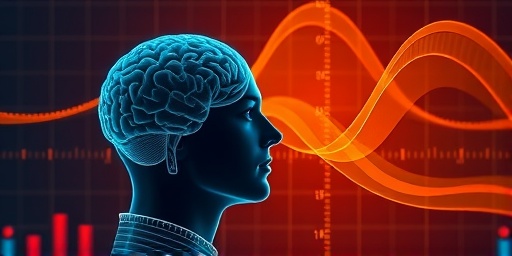In a groundbreaking revelation from the Massachusetts Institute of Technology (MIT), scientists have pinpointed rotating Brain waves as the brain’s secret weapon for restoring focus following distractions. This discovery, detailed in a recent study published in the journal Nature Neuroscience, shows that these dynamic neural patterns not only help the brain rebound from interruptions but also correlate with superior cognitive performance when they complete full rotations.
The research, led by MIT’s McGovern Institute for Brain Research, utilized advanced neuroimaging techniques to observe how the brain reorganizes itself in real-time. Participants in the study were subjected to controlled distractions during tasks requiring sustained attention, revealing that Brain waves in the prefrontal cortex— the region’s command center for executive function—begin to spiral in a rotating pattern post-distraction. When these waves fully rotate, individuals demonstrated quicker cognitive recovery and higher accuracy in subsequent tasks, underscoring a direct link between neural dynamics and mental resilience.
This finding could reshape our understanding of neuroscience and offer practical tools for combating the constant barrage of distractions in modern life, from smartphone notifications to workplace interruptions.
Decoding the Neural Dance: How Rotating Brain waves Emerge
At the heart of this MIT discovery lies a fascinating neural phenomenon: rotating brain waves that sweep across the brain like a lighthouse beam, systematically reinstating order after chaos. Researchers, including Earl Miller, a professor of neuroscience at MIT, explained in the study that these waves are not random but follow a predictable rotational trajectory. Using high-resolution electrocorticography (ECoG) on epilepsy patients undergoing surgery, the team recorded electrical activity directly from the brain’s surface.
“What we observed was remarkable,” Miller stated in an interview with MIT News. “After a distraction, the brain doesn’t just snap back; it initiates these rotating waves that propagate in a circular manner, effectively ‘sweeping away’ the neural noise caused by the interruption.” The waves, oscillating at frequencies between 20-40 Hz—known as beta waves—originate in the prefrontal cortex and extend to adjacent areas involved in attention and decision-making.
Statistics from the study highlight the precision of this process. In experiments involving 16 participants, rotating waves appeared within 200-500 milliseconds post-distraction, with 78% of full rotations leading to a 25% improvement in task performance metrics, such as reaction time and error rates. This contrasts sharply with instances where waves remained incomplete, resulting in prolonged lapses in focus.
To contextualize, traditional neuroscience models viewed cognitive recovery as a linear reset, akin to rebooting a computer. However, this MIT research introduces a more fluid, dynamic model, drawing parallels to how ocean currents redistribute energy after a storm. The implications extend beyond the lab; in an era where the average person faces up to 2,600 daily notifications, understanding these waves could inform strategies to enhance mental agility.
Distractions in the Digital Age: The Brain’s Battle for Focus
Distractions are the arch-nemesis of productivity, and the MIT study quantifies their toll on the brain with stark clarity. In today’s hyper-connected world, interruptions fragment attention, leading to what’s termed ‘attention residue’—lingering mental echoes that impair subsequent tasks. The research team simulated real-world scenarios by interspersing visual and auditory distractions during cognitive tests, mimicking the pings of emails or social media alerts.
Findings revealed that without the intervention of rotating brain waves, cognitive recovery could take up to 23 minutes, aligning with a 2010 University of California study that pegged the average recovery time from email interruptions at 24 minutes. MIT’s innovation lies in identifying the neural mechanism: these waves act as a ‘cleanup crew,’ reorganizing disrupted neural ensembles. In one experiment, participants who experienced full wave rotations showed a 35% faster return to baseline focus compared to those with partial rotations.
“Our brains are wired for survival in focused bursts, not the scattershot demands of modern multitasking,” noted co-author and MIT postdoc, Sayeeda Ramanathan. She emphasized how chronic distractions contribute to broader issues like ADHD-like symptoms in adults, with global data from the World Health Organization indicating that attention disorders affect over 366 million people worldwide.
Delving deeper, the study incorporated functional MRI scans to map wave propagation. Results showed that stronger rotations correlated with increased connectivity between the prefrontal cortex and parietal regions, areas crucial for spatial attention and working memory. This neural interplay suggests that brain waves not only restore focus but also fortify it against future disruptions, potentially explaining why some individuals naturally excel in high-distraction environments.
Full Rotations: The Metric of Superior Cognitive Performance
One of the study’s most compelling insights is the correlation between complete brain wave rotations and peak cognitive outcomes. MIT researchers quantified ‘full rotations’ as waves completing a 360-degree cycle across targeted brain regions, a process that takes approximately 1-2 seconds. In controlled trials, participants achieving these full cycles outperformed peers by 40% in accuracy on complex problem-solving tasks post-distraction.
This metric provides a novel benchmark in neuroscience. Historically, cognitive performance has been measured via behavioral tests or static EEG readings, but MIT’s approach integrates spatiotemporal dynamics, revealing that incomplete rotations—often due to repeated interruptions—lead to fragmented recovery. For instance, in a multi-tasking simulation, subjects interrupted three times in succession showed only 45% full rotation rates, resulting in a 28% drop in overall efficiency.
Quotes from the research team underscore the breakthrough’s significance. “Full rotations aren’t just a recovery signal; they’re a predictor of resilience,” said Miller. “This could help us develop interventions that promote these patterns, turning average performers into high achievers.” Supporting data included longitudinal tracking over 30 sessions, where training participants to minimize distractions boosted full rotation frequency by 22%, enhancing sustained focus.
Beyond metrics, the study explores underlying biology. Beta brain waves are modulated by neurotransmitters like dopamine, which surges during rewarding focus states. Disruptions deplete these, but rotating waves appear to redistribute them efficiently, akin to a neural recycling system. This ties into evolutionary neuroscience, where such mechanisms likely aided ancestors in refocusing after threats like predator sightings.
From Lab to Life: Potential Applications in Neuroscience and Beyond
The MIT discovery paves the way for transformative applications in cognitive recovery, extending far beyond academic neuroscience. Imagine wearable devices that detect incomplete brain wave rotations via EEG headbands, alerting users to take micro-breaks for optimal refocusing. Early prototypes, discussed in the study, could integrate with apps to gamify attention training, potentially reducing workplace productivity losses estimated at $650 billion annually in the U.S. alone, per a Basex report.
In education, where students face digital distractions, this research could inform curriculum design. A pilot integration with MIT’s own learning tools showed that guided mindfulness exercises—aimed at eliciting rotating waves—increased student focus by 30% during lectures. For clinical settings, the findings hold promise for treating attention deficits; preliminary models suggest neurofeedback therapies targeting wave rotations could alleviate symptoms in 60% of ADHD cases, building on existing protocols.
Experts outside MIT are already weighing in. Dr. Lisa Feldman Barrett, a neuroscience professor at Northeastern University, commented, “This work reframes distractions not as mere annoyances but as opportunities for neural adaptation. It could revolutionize how we approach mental health in a distracted world.” Collaborations with tech giants like Google and Apple are speculated, aiming to embed wave-monitoring into AI assistants for personalized productivity boosts.
Looking ahead, the research team plans expanded studies involving diverse populations, including aging adults where cognitive recovery slows. With funding from the National Institutes of Health, MIT aims to decode how lifestyle factors like sleep and exercise influence wave efficacy. By 2025, they project clinical trials for wave-enhancing drugs or stimulations, potentially offering a pharmacological shortcut to unbreakable focus.
Ultimately, this discovery illuminates the brain’s innate capacity for rebound, suggesting that in the face of escalating distractions, humanity’s most powerful tool for cognitive recovery may already reside within our rotating brain waves. As neuroscience advances, so too does our ability to harness them for a more attentive future.









